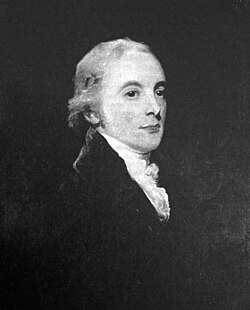Biography:William Gregor
William Gregor | |
|---|---|
 William Gregor (1761-1817) | |
| Born | 25 December 1761 Trewarthenick, Cornwall |
| Died | 11 June 1817 (aged 55) Creed, Cornwall, UK |
| Nationality | British |
| Alma mater | Bristol Grammar School then St John's College, Cambridge |
| Known for | Titanium |
| Scientific career | |
| Fields | Mineralogy |
William Gregor (25 December 1761 – 11 June 1817) was an English clergyman and mineralogist who discovered the elemental metal titanium.
Early years
He was born at the Trewarthenick Estate in Cornwall, the son of Francis Gregor and Mary Copley[1] and the brother of Francis Gregor, MP for Cornwall.[2] He was educated at Bristol Grammar School, where he became interested in chemistry, then after two years with a private tutor entered St John's College, Cambridge, graduating BA in 1784 and MA in 1787.[3] He was ordained in the Church of England. He became vicar of St Mary's Church Diptford[1][4] near Totnes, Devon. He married Charlotte Anne Gwatkin in 1790 and they had one daughter.
Discovery of titanium
After a brief interval at Bratton Clovelly, in 1793 William and his family moved permanently to the rectory of Creed in Cornwall. Here he continued his remarkably accurate chemical analysis of minerals, most of which came from Cornwall, such as the zeolites found in gabbro on The Lizard. He also analysed wavellite, tourmaline, and the uranium minerals torbernite and autunite, the arsenate scorodite, the lead mineral mimetite and the nickel mineral niccolite,[5] and others. But he is best known for one of his earliest discoveries: in 1791, while analysing the minerals in a black sand he had discovered in the Manaccan valley, he isolated the calx of an unknown metal which he named manaccanite.[1] Later in 1791, Martin Heinrich Klaproth discovered what is now known as titanium in the mineral rutile. Believing this to be a new discovery, Klaproth named it titanium after the Titans of Greek Mythology, but eventually it was clarified that Gregor made the discovery first. Gregor was credited with the discovery, but the element kept the name chosen by Klaproth. Gregor later found titanium in corundum from Tibet, and in a tourmaline from a local tin mine. See the main article on titanium for information on its many uses. Titanium is a transition metal with the atomic number of 22 and atomic mass 47.867.
Death and legacy
Gregor was made an honorary member of the Geological Society of London on its inception in 1807, and was a founding member of the Royal Geological Society of Cornwall in 1814.[1] His friends and correspondents included John Hawkins, Philip Rashleigh and John Ayrton Paris. Never letting his scientific work interfere with his pastoral duties, he was also a distinguished landscape painter, etcher and musician. He died of tuberculosis on 11 June 1817 and was buried at nearby Cornelly church.[6]
References
- ↑ 1.0 1.1 1.2 1.3 Boase, G. C.; McConnell, Anita (October 2005). "Gregor, William (1761–1817), mineralogist and Church of England clergyman". Oxford Dictionary of National Biography (online ed.). Oxford University Press. doi:10.1093/ref:odnb/11451. http://www.oxforddnb.com/view/article/11451. Retrieved 2008-05-21. (Subscription or UK public library membership required.)
- ↑ Burke's Genealogical and Heraldic History of the Landed Gentry 1847. on Googlebooks, (Accessed 20 March 2008)
- ↑ "Gregor, William (GRGR780W)". A Cambridge Alumni Database. University of Cambridge. http://venn.lib.cam.ac.uk/cgi-bin/search-2018.pl?sur=&suro=w&fir=&firo=c&cit=&cito=c&c=all&z=all&tex=GRGR780W&sye=&eye=&col=all&maxcount=50. cf. The Times, Monday, 18 June 1787; pg. 3; Issue 776; col C
- ↑ Diptford on Genuki website and Devon Libraries Local History page on Diptford(no mention of Gregor)
- ↑ Russell, Arthur (June 1955). "The Rev. William Gregor (1761-1817), discoverer of titanium". The Mineralogical Magazine and Journal of the Mineralogical Society XXX (229): 617–624. doi:10.1180/minmag.1955.030.229.01. Archived from the original on March 3, 2016. https://web.archive.org/web/20160303182926/http://www.minersoc.org/pages/Archive-MM/Volume_30/30-229-617.pdf. Retrieved 2007-12-09.
- ↑ "Burial, William Gregor, Cornelly Parish". https://www.cornwall-opc-database.org/search-database/more-info/?t=burials&id=3297922.
External links
 |

